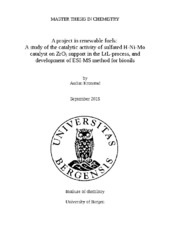A project in renewable fuels: A study of the catalytic activity of sulfated H-Ni-Mo catalyst on ZrO2 support in the LtL-process, and development of ESI-MS method for biooils
Master thesis
Permanent lenke
https://hdl.handle.net/1956/10601Utgivelsesdato
2015-09-18Metadata
Vis full innførselSamlinger
- Department of Chemistry [433]
Sammendrag
Examining the effect of a hydrogenated Ni-Mo catalyst on a zirconia support for the LtL-process and an attempt at developing a method for ESI-MS analysis of the biooils produced. Biofuels produced from lignocellulosic materials have the potential to serve as a good substitute or supplement to the fuels produced from conventional sources. The chemical similarity between biooil and conventional oil also allows for the potential production of a wide range of platform chemicals. The utilization of the carbohydrates in the lignocellulosic biomass is near commercialized, but 1/3 of the biomass consists of the component lignin. Lignin-to-liquid is a termochemical solvolysis process that utilizes formic acid as a hydrogen donor to depolymerize and deoxygenize the lignin polymers. The oxygen content of the oils produced by lignin-to-liquid is generally higher than that of conventional oils, reducing the quality of the oil. Further oimprovement of the process can be obtained using catalysts to increase hydrogenation and oxygen removal. The hydrogenated Ni-Mo catalyst on a zirconia support was tested for catalytic activity in the range 300-380 ºC and 2-10 hours reaction time. A good experimental result is characterized by high yield and H/C-ratio, and a low O/C-ratio. The yield of the catalyzed experiments was higher than the uncatalyzed, as well as the H/C-ratio. The O/C-ratio was higher for the catalyzed experiments. Characterization of the oils was done by GC-MS, GPC and elemental analysis. The development of an ESI-MS method for analysis of the oils was attempted. No method was successfully developed to allow for ionization of the compounds in the mixture not containing nitrogen.
